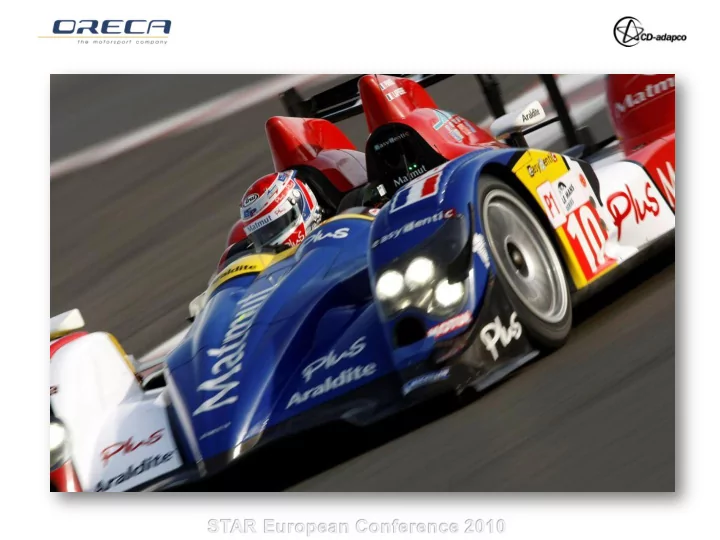

STAR European Conference 2010 AERODYNAMICS DEVELOPMENTS ON A LE MANS PROTOTYPE ORECA 01 LMP1
PRESENTATION 1. ORECA Presentation 2. Why we use CFD? 2009 Aero Development 2010 Aero Development 3. Methodology Correlation Case Studies Mesh Results Conclusions
1. ORECA ORECA: Since 1972 180 People 35 to 40 Millions Euros / year 4 divisions: Engine department (Magny-Cours) Marketing + Incentive Race parts + accessories sales Race team + Chassis Engineering
1. ORECA ORECA: RACE TEAM: Endurance Racing (LMP1 – 2 cars) Audi R8 GT3 (French GT – 2 cars) Formula Le Mans Other projects (engineering / production) Engineering: 11 Engineers Aero-group : 6 engineers, 4 working on Star-CCM+
2. Why we use CFD? 2009 CFD Development We used CFD for : - Comprehension of LMP aerodynamics - Keep the development of aero-package up through the season We chose Star-CCM+ for : - Only one interface - Ratio simplicity / accuracy / cost - Evolution of the Software through the year
2. Why we use CFD? 2009 Aerodynamic Development: Oreca 01 : • Adapt to new ACO Aerodynamics rules (reduction of the rear wing dimensions) • New aero-package for Courage LC70E LMP1 Tests : ~80% Wind tunnel, ~20% CFD • 320 runs using a 40% scale model in ACE wind-tunnel (Magny-Cours). • CFD development : 1 engineer (1 Workstation) working on Star-CCM+ / +80 simu.
2. Why we use CFD? 2009 CFD Development History ORECA 01 V1: introduced in 1000 km Spa (May 2009) ORECA 01 V2: introduced in 1000 km Silverstone (Sept. 2009). Developped 100% using CFD. Increasing Efficiency and Downforce Efficiency 115 112.5 110 107.5 105 102.5 100 97.5 95 2008 car 2008 car + ORECA 01 ORECA 01 2009 wing V1 V2
2. Why we use CFD?
2. Why we use CFD?
2. Why we use CFD? Qualifying performances Le Mans Serie 2009 7 ORECA 01 Position Aston Position 6 5 4 3 2 1,5 1 0,082 0 -0,141 -0,916 -1 Race1 Barcelone Race2 Spa Race3 Algarve Race5 Silverstone
2. Why we use CFD? 2010 Aerodynamic Development: Oreca 02 : • New LMP1 car designed to compete for 24H of Le Mans (2011) with Peugeot Engine Tests : ~20% Wind tunnel, ~80% CFD • CFD development : 4 engineers on Star-CCM+ • 4 Workstations, 1 Cluster of 128cores / 130 simulations in 1,5 month Why we use more CFD in 2010? Ratio Cost / Efficiency Understanding the phenomena and not iterating mechanically Aero development through the year Investment : cluster and SKILL New skills = new business opportunities
3. Methodology Methodology: Correlation Straight-Line Test with the real Car Lift : calculated with Loadcells on each suspension + Pitot sensor Constant speed Drag : Coast-down. All the values are stored in a PI Data Analysis System: - 4 Loads - Aero Speed - Ride Heights Front and Rear - Acceleration X, Y, Z - Ground Velocity
3. Methodology Methodology: Case Studies Straight-Line Half-car with different Ride Heights Yaw / Roll Full car with Yaw, Roll, Steering Angle
3. Methodology Slipstream LEADING CAR FOLLOWING CAR LEADING CAR FOLLOWING CAR Front DRAG LIFT EFFICIENCY BALANCE
3. Methodology Mesh / Solver Mesh : Wrapper + Trimmer + Prism Layer From 12M, up to 45M of cells Physics : - Steady cases - Unsteady : coming soon... - Porous Region for Radiators - Velocity specification on wheels and Floor - RANS + SST K-Omega
3. Methodology
3. Methodology
3. Methodology Results 90% of the post-treatment is automated: Scenes – Starview files Analitic Results : force reports, mass-flow Force and Mass-flow reports automated by Java macros All Results compiled in Excel File
3. Methodology Results - Starview
3. Methodology
3. Methodology
3. Methodology
3. Methodology
3. Methodology
3. Methodology
3. Methodology Results – Analytic By macros, we export analytic results: – Forces on each parts – Mass Flow : brake ducts, radiator – Flow around the underfloor : velocity, pressure, angle – Plots of Coefficient of Pressure : Rear Wing, Front Wing, Undefloor, Diffuser
3. Methodology – Forces on each parts
-30% -20% -10% 10% 20% 30% 40% 50% 0% 23% Wing 43% Front Splitter 39% Flat Bottom 17% Diffuser -19% Bodywork -1% Front Wheel SCZ 3. Methodology 0% Rear Wheel -1% Internal -30% -20% -10% 10% 20% 30% 40% 50% 0% 17% Wing 19% Front Splitter 9% Flat Bottom 13% Diffuser 11% Bodywork 3% Front Wheel SCX 8% Rear Wheel 20% Internal
3. Methodology – Flow around the underfloor : velocity, pressure, angle
3. Methodology – Plots of Coefficient of Pressure : Rear Wing, Front Wing, Undefloor, Diffuser
Conclusions Since 2 years, ORECA has invested a lot to increase its know-how, methodology and tools to carry extensive Aero development programs on Le Mans Prototypye. We started from Zero and have now an efficient aero-group. Our staff is on a steep learning curve. The effort we have put in the Aero development started to pay off at the end of the 2009 season. We expect a bigger gain to come with the new LMP1. We open with the CFD new business opportunities Our aim is to fight with factory Teams in 2011.
Special Thanks to Vincent Keromnès, Christian Fauchier, Christophe Gayet from CD Adapco France. ORECA’s technical partners: CD Adapco, Dassault System, Araldite, MSC Software.
Recommend
More recommend